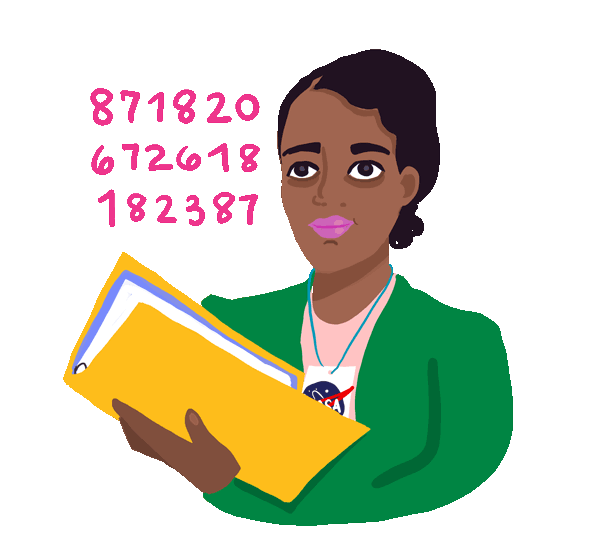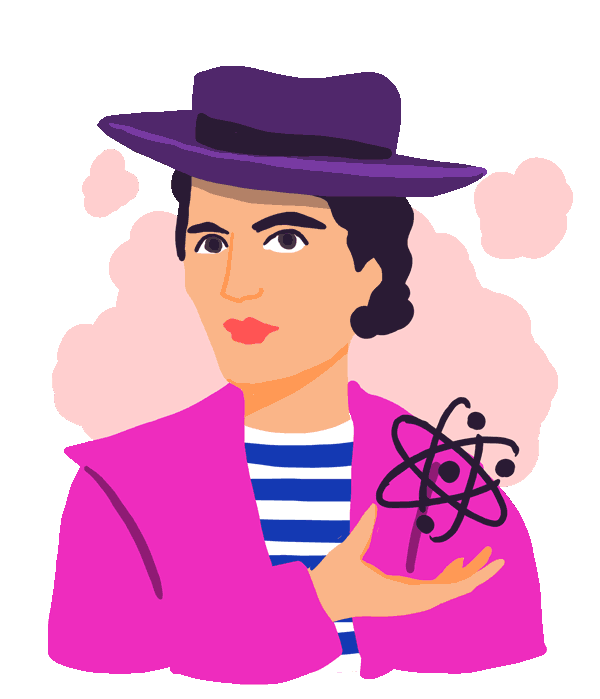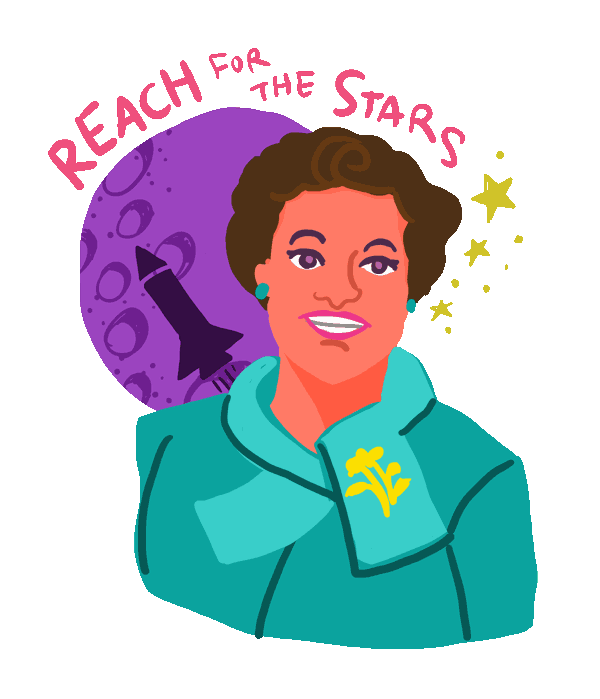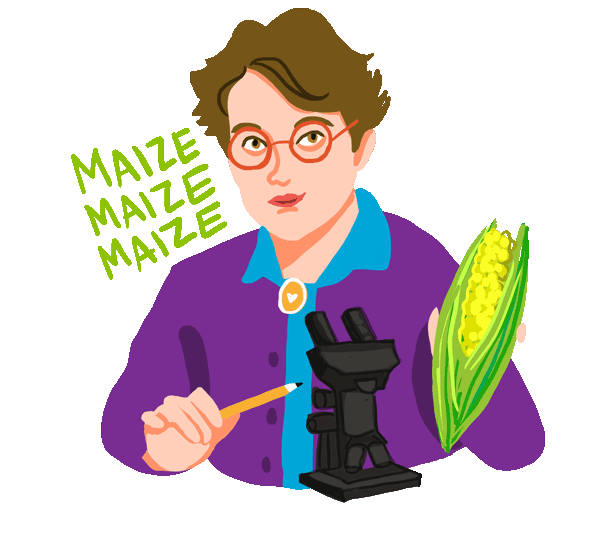GIPHY Engineering Celebrates Women’s History Month!
March 7, 2019 by

March is Women’s History Month! For this year’s special month, GIPHY Engineering is celebrating with a whole new sticker pack dedicated to Women Pioneers in STEM.
All stickers were illustrated and brought to life by the amazing Denyse Mitterhofer, and you can find them on GIPHY.com, the GIPHY mobile app and anywhere you get your favorite GIPHY content!
Keep reading to see the 15 women pioneers in STEM we’re honoring, in no particular order.
Historical Figures:
 Grace Hopper
Grace Hopper
Grace Hopper (1906-1992), AKA Amazing Grace, was an American computer scientist and United States Navy rear admiral. “A pioneer in the field, she was one of the first programmers of the Harvard Mark I computer” writes Scientific Women, “and invented the first compiler for a computer programming language.”
 Ada Lovelace
Ada Lovelace
Ada Lovelace (1815-1852), sometimes referred to as the “Prophet of Computer Age,” was an “English mathematician and writer, chiefly known for her work on Charles Babbage’s proposed mechanical general-purpose computer, the Analytical Engine” according to Scientific Women, “she was the first to recognize that the machine had applications beyond pure calculation, and created the first algorithm intended to be carried out by such a machine”
Sister Mary Kenneth Keller
Sister Mary Kenneth Keller (1913-1985) “was the first woman in the US to be awarded a PhD in Computer Science in 1965, having previously studied Mathematics and Physics. Earlier she had taken her vows as a Roman Catholic religious sister in Ohio and in 1958 had started work at Dartford College in the male-only (at the time) computer centre” writes Computing History.
 Hedy Lamarr
Hedy Lamarr
Hedy Lamarr (1914-2000) was an Austrian-American actress and inventor who pioneered the technology that would one day form the basis for today’s WiFi, GPS, and Bluetooth communication systems” writes Women’s History. “As a natural beauty seen widely on the big screen in films like Samson and Delilah and White Cargo, society has long ignored her inventive genius.”
Lisa Meitner
Lise Meitner (1878-1968) was an Austrian physicist who “was part of the team that discovered and explained nuclear fission and foresaw its explosive potential” writes the Atomic Heritage Foundation. “She refused to work on the Manhattan Project at Los Alamos, declaring, “I will have nothing to do with a bomb!” Her epitaph on her gravestone, written by her nephew Otto Frisch, reads, “Lise Meitner: a physicist who never lost her humanity.””
Rukhmabai Raut
Rukhmabai Raut (1864-1955) was one of the first women doctors to practice medicine in British India and staunchly opposed child marriage” writes Indian Express. “Raut went on to become India’s first qualified physician and was the major cause behind the enactment of Age of Consent Act in 1891.”
 Martha Euphemia Lofton Haynes
Martha Euphemia Lofton Haynes
Martha Euphemia Lofton Haynes (1890-1980) earned degrees in both mathematics and education, and in 1943 became the first African-American woman to receive a Ph.D. in mathematics. “She then took the educational system by storm, teaching in a wide variety of settings and pushing continually to change the face of education, which, at the time, often found black students falling into a system of de facto segregation” writes biography.com.
 Mary Golda Ross
Mary Golda Ross
Mary Golda Ross (1908 – 2008) was the first known Native American female engineer, and the first female engineer in the history of Lockheed. “She is a pioneer in the research, development and application of the theories and concepts of ballistics, orbital mechanics and astrophysics, and is the first woman engineer in the history of Lockheed” reads her biography on the Silicon Valley Engineering Council Hall of Fame.
 Wang Zhenyi
Wang Zhenyi
Wang Zhenyi (1768–1797) was a famous scientist from the Qing dynasty. “She breached the feudal customs of the time”, writes Scientific Women “which hindered women’s rights and arduously worked to educate herself in subjects such as astronomy, mathematics, geography, and medicine. She was a very strong and intelligent woman well known for her contributions in astronomy, mathematics, and poetry.”
 Dorothy Vaughan
Dorothy Vaughan
Dorothy Vaughan (1910-2008) “was an African American mathematician and human computer who worked for the National Advisory Committee for Aeronautics (NACA), and NASA, at Langley Research Center in Hampton, Virginia. In 1949, she became acting supervisor of the West Area Computers, the first African-American woman to supervise a group of staff at the center” according to Scientific Women.
 Barbara McClintock
Barbara McClintock
Barbara McClintock (1902-1992) was an American scientist who revolutionized the field of cytogenetics with her studies of chromosomes in corn. According to Biography.com, “she discovered the role of “controlling elements” in genetic regulation and transposition. Her work was considered too radical (or simply ignored) until it was replicated in the late 1960s. McClintock received the Nobel Prize in 1983.”
 Dorothy Hodgkin
Dorothy Hodgkin
Dorothy Hodgkin (1910-1994) was a British chemist who developed protein crystallography, which lead to her winning the Nobel Prize in Chemistry in 1964. According to Scientific Women, “among her most influential discoveries are the confirmation of the structure of penicillin as previously surmised by Edward Abraham and Ernst Boris Chain, and the structure of vitamin B12, for which she became the third woman to win the Nobel Prize in Chemistry.”
 Elizabeth Garrett Anderson
Elizabeth Garrett Anderson
Elizabeth Garrett Anderson (1836-1917) was a pioneering physician and political campaigner, known as the first Englishwoman to qualify as a doctor. According to BBC, after being refused admission to study at medical schools in London, due to her gender, Anderson taught herself French and went to the University of Paris, where she successfully earned her degree. Later in her career, she “founded the New Hospital for Women in London (later renamed after its founder), staffed entirely by women.”
Current Trailblazers:
 Carol Shaw
Carol Shaw
Carol Shaw, is one of the first professional female video game designers, and is the programmer behind one of the Atari’s best-known shooter games, River Raid. River Raid was revolutionary because, for first time, it let gamers experience an inordinate amount of non-random, repeating terrain despite constrictive memory limits. River Raid was the first game that allowed the shooter to accelerate and slow down all over the screen. You can learn more about her from Computing History.
 Radia Perlman
Radia Perlman
Radia Perlman often described as the ‘Mother of the Internet,’ insists that, “the Internet was not invented by any individual.” Perlman did, however, create the algorithm behind the Spanning Tree Protocol (STP), which is an essential part of the Internet’s underlying foundation. You can learn more about her story and accomplishments from BBC.
– GIPHY Engineering
A word from the artist:
“It’s always exciting to work with GIPHY on any project. Especially when it comes to producing really awesome GIF stickers about incredibly smart and influential women who undoubtedly changed the world.
As a creative, I feel so lucky that I get to create fun, colorful animations for others to share and talk about, while also learning. I hope I’ve done these courageous women justice with their tiny animated portraits. They were all surely created with lots of respect, admiration and love and I hope it translates!”
– Denyse Mitterhofer, Art Director by day, compulsive GIF creator by night
– GIPHY page: dmitterhofer
– IG: @dmitterhofer